The increasing population, technological advancements, and materialistic living standards have significantly increased the energy demand for cooling devices in the last few decades. The air conditioner has moved on from a luxury to becoming a comfort point. In modern day and time it has now become a necessity. This true for all areas be it mission critical applications, be it infrastructure such as hotel and hospitals, or commercial buildings and now even most new homes in India are centrally air-conditioned.
The technical term for the air conditioning industry globally is Heat Ventilation and Air Conditioning (HVAC), though in India we are yet to develop heating applications for buildings and facilities even in north India where they do experience low temperatures. While the demand and market for air conditioners has grown tremendously, the industry has also become the biggest threat to environmental pollution.
The HVAC industry has fully grown and created a huge business opportunity for consultant, interior designers, architect, contractors as well as manufacturers. But as a whole, there needs to be an understanding and move towards the criticality of the environment. The onus is on the manufacturers to come up with new engineering designs to reduce the impact, and come up with energy efficient alternates of air conditioning. As the industry matures, its social responsibility also grows. Based on these new designs are being done.

Design Requirements and Application areas
If you talk about mission critical applications like laboratories, test chambers etc or facilities like hospitals, the HVAC design depends on the machine requirement. In such critical module buildings it is the engineer alone who decides and designs the HVAC requirements. These critical types of buildings comprises of facilities in the power segment, space research, R &D. These types of buildings have very specific and preset requirements for air conditioning and ventilation.
For commercial buildings like office complexes or other commercial facilities generally of the owner or tenants of the building are the key personnel deciding on the HVAC requirement and the deliverables. Owners are more concerned about the operating cost of the building and on return on investment that they get. Tenants earlier had less interest on issues pertaining to design and energy efficiency. Now peer pressure and social and technical awareness is pushing tenants to adhere to a more conservative approach. Taking the lead are the MNC companies, who are now very concerned and conscious of these issues. They are interested and open to trying new initiatives and technologies. They are professional in their approach and try to strike a balance between operating expenses and capital expenses. But there is still room for a development of efficiency operating in regards to commercial buildings.
Hotel industry until now had very limited scope for contribution in the energy conservation. These and other hospitality facilities either went in for chilled water based systems or individual room wise air conditioning. The customer had no concern about shutting the units during non usage hours as it had no impact on the final bill payment.
But now the hospitality segment has become consciously critical of energy conservation right at the design stage as they generally go for cost per square feet development that is already pre-defined by the developer and the architect. The consultants and contractors generally have to work on the basis of these predefined norms set out to them.
Cities like Bangalore and Pune have moved from a design norm of 400 square foot per ton of air conditioning, while other cities are still in between 150 – 250 square feet per tonne. The actual possibility is 900 square foot per tonne provided the base building is built with such norms in mind.
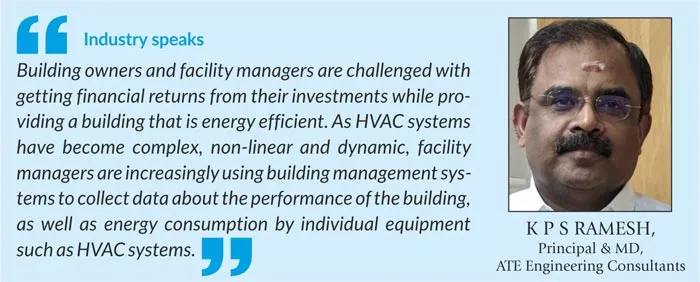
Technical Analysis
Technically the norm of comfort cooling is at 23 degrees plus/minus 1 degree centigrade. This is the basic comfort design done with a relative humidity of 50- 60 percent. Hotels works between 19degrees centigrade to 21 degrees centigrade, wherein 19 degrees centigrade is the room temperature and 21 degrees centigrade is the standard for the common area. Apart from this evaporation control has to be managed. Evaporation control is the loss of evaporation or humidity from the human body when the temperature changes along with the wind factor. In fact, in airports air pressure can be increased so that comfort is still maintained in higher temperatures. But in office areas, there needs to be set point temperature and wind speed that needs to be managed. Moreover, fresh air and carbon dioxide level have to be balanced. Government policy also has to play a role in large facilities. Government policy as of now, do not allow sub metering so that individual billing could be done rather easily. If sub metering is allowed then large facilities can have district cooling, which would bring about a huge reduction in both capital costs as well as operating costs, thereby making air conditioning more affordable and less polluting.
25 degrees centigrade is the inside temperature norm is what the government wants to set. Even though it is difficult for the hotel industry immediately, but it would certainly help if the government institutions can with their own facilities and buildings so that an example could be set. There needs to be the management of relative humidity is also equally important. In coastal areas, 25 degrees centigrade is easily achievable.
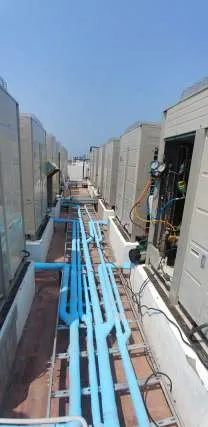

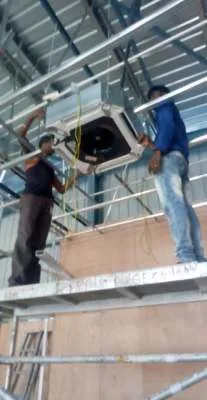
Types of Air conditioning systems and products
Chilled water based cooling systems were the only systems available for larger and centralised cooling applications. They could cool large areas very efficiently and effectively, but required a lot of designing and were heavy on maintenance. If you want an energy-efficient aircon unit visit https://www.airwaresales.com.au/brand/air-conditioners/stiebel-eltron/ for more
In midsized areas ducted and packaged units were almost the norm until the late 90s. The packaged air conditioner has specific applications depending on the building structure and the requirement of cool air volume.
The domestic segment had only the humble window type air conditioner which was a status symbol as many would remember. Gradually the window unit was replaced with the split air condition which offered better comfort in terms of noise and aesthetics.
All of these systems had a tough competition technically when Variable Refrigerant and Variable Compressor performance based systems were introduced in the market. Popularly known as VRF Systems, they offered the benefit of larger Outdoor capacities as well as the versatility of choice of indoor units. In larger multi user facilities and hotels they also allow flexibility of personalised temperature settings as well as centralised monitoring of power consumption and control. B N Pandey, Partner in Ozone VAC a leading contracting company and a multi brand dealer, feels that VRF systems have taken away a major share of the market in commercial and are almost becoming the standard in luxury and upmarket homes. Brands like Mitsubishi, Toshiba, General and Daikin are pegged in the luxury brand segments. They also enjoy the perception of quality associated with Japanese brands. Korean brands like LG and Samsung along with Panasonic, Carrier Midea and Haier have a fair market share amongst other foreign brands. Voltas and Blue Star are amongst the reputed domestic brands in the commercial HVAC space.
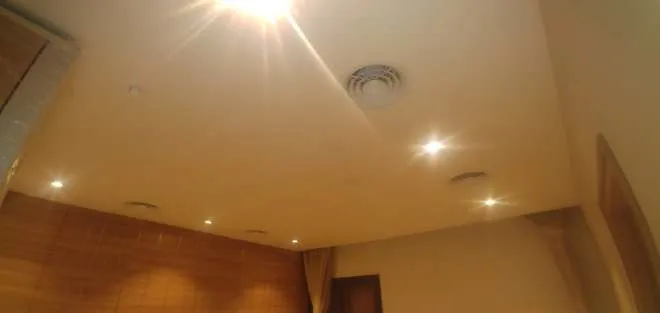
Architect’s angle
Energy efficiency is a key factor in the building. In today’s time, in a cost-effective world, the architect’s basic aim is to balance the scale between the capital expense and operating expense. This is a key factor for architects when they work with a builder. Apart from this, an architect’s basic design focuses on aesthetics and functionality. Architectural challenges include aesthetic relating to the facade and outdoor noise insulation. Another critical area is balancing between natural light and ventilation while keeping the heat radiation to comfortable levels. Thirdly their design diligence includes the concealment of mechanical equipment keeping in mind the visual appeal of the building. Proper position of units to get fresh air, is also an important point to consider.

Builder’s angle
For the builder, the main challenge is that of finances. As the investment is huge they go for phase-wise development. They need to start planning and buying equipment’s for air condition even before the tenants come in. Doing occupancy wise fitment of HVAC equipment often adds to the cost. Builders need to keep an eye on balancing the life of the equipment versus the usage.
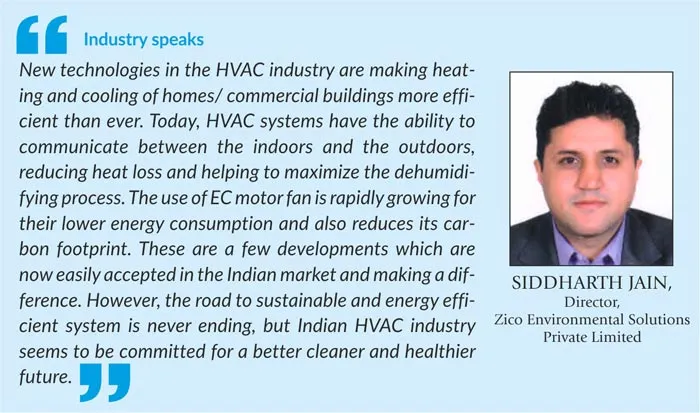
Types of Air conditioning systems and products
Chilled water based cooling systems were the only systems available for larger and centralised cooling applications. They could cool large areas very efficiently and effectively, but required a lot of designing and were heavy on maintenance.
In midsized areas ducted and packaged units were almost the norm until the late 90s. The packaged air conditioner has specific applications depending on the building structure and the requirement of cool air volume.
The domestic segment had only the humble window type air conditioner which was a status symbol as many would remember. Gradually the window unit was replaced with the split air condition which offered better comfort in terms of noise and aesthetics.
All of these systems had a tough competition technically when Variable Refrigerant and Variable Compressor performance based systems were introduced in the market. Popularly known as VRF Systems, they offered the benefit of larger Outdoor capacities as well as the versatility of choice of indoor units. In larger multi user facilities and hotels they also allow flexibility of personalised temperature settings as well as centralised monitoring of power consumption and control.
Conclusion
Maintaining optimal temperature and air circulation are the basis of a comfortable indoor environment. This role is played by HVAC (Heating, Ventilation and Air conditioning) systems. All heating, ventilation and air conditioning system account for 60% of the World’s total domestic energy consumption.

